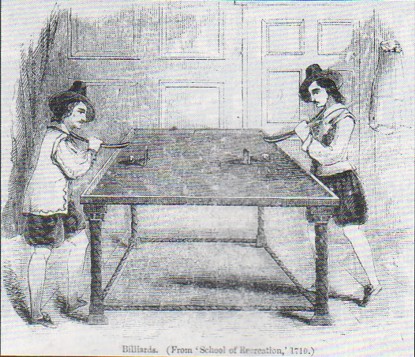
Days of Old number 1
The origin of the game of Billiards
The origin of the game of Billiards is very obscure, although many efforts have been made to trace its history, always without success. There are in existence a number of “theories” or “anecdotes” which endeavour to explain the origin of the game and the reader must choose whichever ‘story” is preferred. One thing however is absolutely definite, it is an extremely old game which has gradually developed so that the present day game is completely unrecognisable from the original.
It is said by some writers that a game similar to Billiards was seen by a traveller called Anacharsis in Ancient Greece some 400 years B.C. We certainly have proof that Billiards was played during the reign of Elizabeth I, as Shakespeare in the play “Anthony and Cleopatra” has the Queen say to her Maid – “Come, Charmain, let us to Billiards”. Note, however, whilst this certainly indicates that Shakespeare was acquainted with the game, it does not mean that it was known in Ancient Egypt.

It is accepted that the game was originally played on the ground out of doors and that it is related to the game of Croquet. This theory is supported by early illustrations and pictures, showing hoops and also a post (similar to Croquet) on the surface of the Billiards Table (see the illustrations) and that from the lawn it was bought indoors and for convenience raised to table height.
One “story” explaining how the game came to he called “Billiards” relates how a Pawnbroker by the name of William Kew, who, after losing the shop, used to take the three brass balls of his sign and used them to play in the yard behind the shop – his friends used to join him, saying they were going to play at Bill`s Yard”!! Maybe his name also explains why the instrument which wa use to propel the balls is called a “Cue”.
Two different forms of the game developed – in most European Countries Billiards is played on a table without pockets (and so unfortunately for them they cannot play the more recently developed game of Snooker). Whilst the British Billiards Table as we all know has six pockets. One result of this difference is that wherever in he world British Emigrants and Colonists settled and established themselves they took with them the English version of the game whilst the French, Spanish and Dutch settlers introduced the Continental game of Billiards without pockets to their colonies and this is the game they still play in their sphenes of influence. It is perhaps also interesting to note that it was the Spaniards who first took the game to what is now the U.S.A. by introducing Billiards to St. Augustine. Florida in 1565 and so to this day, if you play Billiards in the U.S.A. it is the Continental game. and every year American Players take part in the “World 3 Cushion Billiards Championships”. It is also the rules of this game of Billiards which are published in the handbook of the Billiards Congress of America and they do not play English Billiards”. (Note: – In the U.S.A. you play their various gamas of “Pool” on a “Pocket Billiard Table” so called to distinguish it from a “Billiards Table”).

When the game was first brought indoors, and raised to table height – the bed was made of wood – and as will be seen from the illustration “Billiards” (from the School of Recreation 1710), a plain wooden rim without any form of cushioning surrounded the table to prevent the balls from falling on the floor. The tables were of lightweight construction – Maces were used to propel the balls and the balls themselves were also originally made of wood – there were no properly established rules and the dimensions of the Billiard Table itself – the size of the balls and the pocket openings etc all varied. In this respect it is interesting to note that an old book of rules in the possession of the writer printed in 1779 allowed the player to use the point of the cue or the butt of the cue!
Norman Clare
© 1990 Norman Clare / 2018 E A Clare & Son Limited
Reproduction of this article allowed with permission from E A Clare & Son Limited





